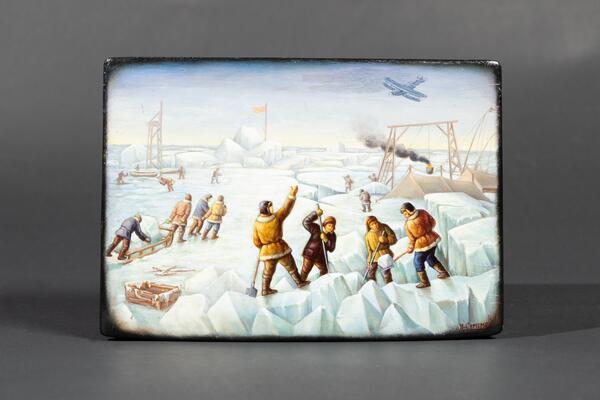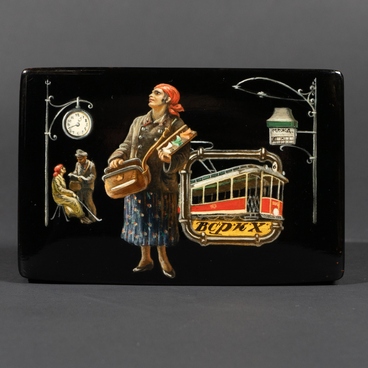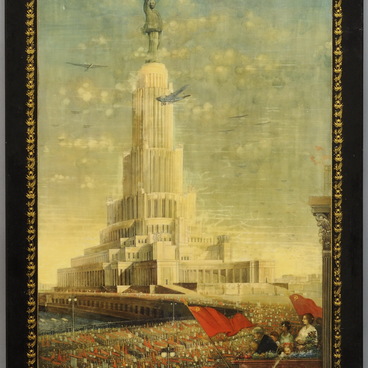The box ‘Chelyuskintsy’ by Fedoskino master Ivan Semenov was painted in the mid-1930s. At that time, the Fedoskino artel collaborated with the Scientific Research Institute of Art Industry (SRIAI).
In the 1920s and 1930s, masters tried to create compositions in a realist way which were not typical of the craft. Samples — drawings for paintings — were based on modern topics of that time: they glorified the achievements of workers, and the heroism of the builders of socialism. A creative group of artists from SRIAI and the best masters of the Fedoskino artel worked on the samples. Among them was Ivan Semenov.
The miniature ‘Chelyuskintsy’ refers to the events of February 13, 1934. The steamship ‘Chelyuskin’ with a scientific expedition on board led by Otto Schmidt, who was a world-renowned scientist, was caught in the ice fields in the Chukchi Sea and sank. 104 people, including two small children, set up a camp on an ice floe in the difficult conditions of the polar winter. Pilots of the newly established polar aviation of the USSR did what seemed impossible at that time: within two months they made 24 flights and rescued all members of the expedition. On June 19, 1934, the Chelyuskintsy were solemnly welcomed by the leaders of the state and residents of the capital on Red Square in Moscow.
The rescue of the expedition of the steamer ‘Chelyuskin’ had a great resonance not only in the Soviet society, but also around the world. The pilots who participated in the evacuation were awarded the highest title of Hero of the Soviet Union for the first time in history. They were Mikhail Vodopianov, Ivan Doronin, Nikolai Kamanin, Sigizmund Levanevsky, Anatoly Liapidevsky, Vasily Molokov, and Mavriky Slepnev.
The participants of the scientific expedition, who survived in the difficult conditions of the North, were awarded the Order of the Red Star. Many participants of the events wrote memoirs about these events, various directors made documentaries and feature films. The perseverance of the Chelyuskintsy was also praised by poets. For example, Marina Tsvetaeva dedicated the following lines to them:
In the 1920s and 1930s, masters tried to create compositions in a realist way which were not typical of the craft. Samples — drawings for paintings — were based on modern topics of that time: they glorified the achievements of workers, and the heroism of the builders of socialism. A creative group of artists from SRIAI and the best masters of the Fedoskino artel worked on the samples. Among them was Ivan Semenov.
The miniature ‘Chelyuskintsy’ refers to the events of February 13, 1934. The steamship ‘Chelyuskin’ with a scientific expedition on board led by Otto Schmidt, who was a world-renowned scientist, was caught in the ice fields in the Chukchi Sea and sank. 104 people, including two small children, set up a camp on an ice floe in the difficult conditions of the polar winter. Pilots of the newly established polar aviation of the USSR did what seemed impossible at that time: within two months they made 24 flights and rescued all members of the expedition. On June 19, 1934, the Chelyuskintsy were solemnly welcomed by the leaders of the state and residents of the capital on Red Square in Moscow.
The rescue of the expedition of the steamer ‘Chelyuskin’ had a great resonance not only in the Soviet society, but also around the world. The pilots who participated in the evacuation were awarded the highest title of Hero of the Soviet Union for the first time in history. They were Mikhail Vodopianov, Ivan Doronin, Nikolai Kamanin, Sigizmund Levanevsky, Anatoly Liapidevsky, Vasily Molokov, and Mavriky Slepnev.
The participants of the scientific expedition, who survived in the difficult conditions of the North, were awarded the Order of the Red Star. Many participants of the events wrote memoirs about these events, various directors made documentaries and feature films. The perseverance of the Chelyuskintsy was also praised by poets. For example, Marina Tsvetaeva dedicated the following lines to them:



